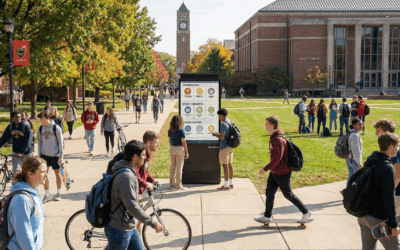The Travel Funnel Has Fractured and Google Owns the Top
Once upon a time, travelers planned trips through tourism websites and booked directly with hotels.
Today, 70% of travelers begin their journey on Google, and nearly two-thirds of hotel bookings now originate through Google’s travel surfaces — Maps, Hotel Ads, and price comparisons (Skift Research, 2024).
That shift has rewritten tourism economics.
- DMOs have lost the first touch in the visitor funnel.
- Hotels have lost the last one.
What connects both losses is the same truth: digital intermediaries now sit between destinations, properties, and the people actually visiting them.
But while discovery may be dominated by algorithms, ownership of the visitor relationship — what happens once they arrive — remains completely up for grabs.
The Fragmented Funnel: Who Really Owns the Visitor?
For DMOs
Even if travelers search “things to do in Asheville” or “Visit Colorado”, they’re greeted first by Google’s curated “Travel Guides,” not your destination website.
Organic traffic to DMO pages has dropped 40-60% since 2020 (Think with Google, 2023).
That means less influence over what visitors see, do, and ultimately book.
For Hotels
OTAs and Google Metasearch drive visibility, but at a cost: 15–30 % commission per booking, and the loss of direct guest data (Phocuswright, 2024).
That’s over $27 billion in global commissions — money that once funded local marketing, upgrades, or staff training.
In this fractured system, both sides lose control of their most valuable asset: first-party visitor data.

You Can’t Outspend Google But You Can Out-Experience It
Google wins because it controls attention, not hospitality.
Trying to out-bid Expedia or Booking.com for ad placement only deepens dependence.
But there’s one arena Google can’t reach — the physical guest experience.
When a visitor arrives at your destination or hotel, the algorithm fades.
That’s where ownership can be rebuilt — through kiosks, local apps, and connected visitor hubs that bring digital intelligence into physical space.

The Missing Layer: On-Site Digital Ownership
For DMOs
Interactive kiosks act as digital visitor centers that:
- Showcase attractions, partner hotels, and events.
- Capture anonymous visitor analytics — what travelers search for, dwell time, and engagement patterns.
- Redirect visitors from generic Google listings to local, verified experiences.
- Strengthen relationships with partner hotels through shared visibility.
For Hotels
Lobby kiosks evolve from check-in machines into re-engagement tools that:
- Enable self-check-in/out and upsells (spa, dining, tours).
- Collect guest feedback and preferences.
- Encourage direct re-booking before checkout (“Book your next stay direct – 10 % off”).
- Capture first-party data for loyalty marketing.
Together, DMOs and hotels can rebuild a shared data infrastructure — one that keeps the traveler inside their ecosystem instead of outsourcing it to OTAs or Google.

Case Study: When a City Took Back Its Visitors
A mid-sized destination in Colorado installed HootBoard AirX kiosks in its visitor center, downtown streets, and partner hotels.
In just six months:
- 27 % increase in direct hotel bookings traced to kiosk referrals.
- 14 % rise in website visits from on-site QR codes.
- Over 50,000 visitor interactions, generating insights on traveler interests by geography and season.
Hotels used this data to target returning guests with direct-booking offers, while the DMO refined seasonal marketing spend based on actual visitor demand patterns.
That’s not just marketing automation — it’s destination intelligence.

The DMO–Hotel Partnership Model
How it works
- DMO installs kiosks at high-traffic public points (airports, downtown, museums).
- Hotels deploy kiosks in lobbies or partner venues.
- Both connect through HootBoard OS — the same backend that synchronizes listings, events, and analytics.
- Every touchpoint feeds a shared analytics layer, letting both sides see what visitors search, book, and engage with.
ROI for DMOs
- Prove impact to stakeholders with quantifiable visitation data.
- Strengthen local partnerships through measurable lead sharing.
- Reduce dependency on paid search or OTA referrals.
ROI for Hotels
- Reduce commission costs.
- Increase repeat-guest revenue.
- Get access to destination-level analytics from their DMO — a 360-degree view of traveler intent.

The Joint Action Plan for Direct-Booking Growth
Step 1 — Audit your ecosystem
Identify every digital and physical touchpoint — search, website, arrival, stay, departure — and note where third-parties own the interaction.
Step 2 — Integrate technology
Link kiosk platforms with PMS, CRM, and DMO databases to ensure unified data capture.
(HootBoard OS APIs already support these connections.)
Step 3 — Incentivize direct action
Promote “Book Direct & Save” or “Stay Local Pass” offers on kiosks and mobile apps.
Reward sign-ups to loyalty programs or newsletter opt-ins.
Step 4 — Measure shared success
Key metrics:
- Direct vs OTA booking ratio
- Visitor engagement per kiosk
- Data capture rate
- Repeat visit rate
Report these jointly between DMOs and hotels to quantify ecosystem impact.
From Clicks to Footsteps: Building the Post-Google Tourism Model
The new travel economy won’t eliminate Google — it will rebalance it.
Discovery will still start online, but loyalty and insight will belong to the destinations and properties that invest in owned experiences.
Kiosks, apps, and smart signage form the physical interface between digital curiosity and local authenticity.
They turn anonymous clicks into real-world data — showing DMOs what visitors actually do and giving hotels tools to turn those visits into relationships.
It’s not about resisting platforms; it’s about designing a smarter one that serves your region first.

Technology That Connects It All – HootBoard’s Role
HootBoard was built for this intersection of tourism and technology.
- AirX kiosks act as on-site engagement touchpoints for both destinations and properties.
- HootBoard OS unifies content, events, and partner offers across all screens.
- Analytics Dashboard turns visitor interactions into actionable insights — helping DMOs prove impact and hotels personalize follow-ups.
It’s not just hardware — it’s an ownership layer for the visitor economy.

The Road Ahead: From Data to Connection
“The winners in tourism will be those who own the guest journey — from inspiration to check-out.”
DMOs and hotels no longer have to choose between dependence and obscurity.
By building a connected network of kiosks and direct-booking experiences, they can reclaim what was always theirs: the visitor relationship.
Turn your city, your lobby, and your experiences into your own booking engine.




